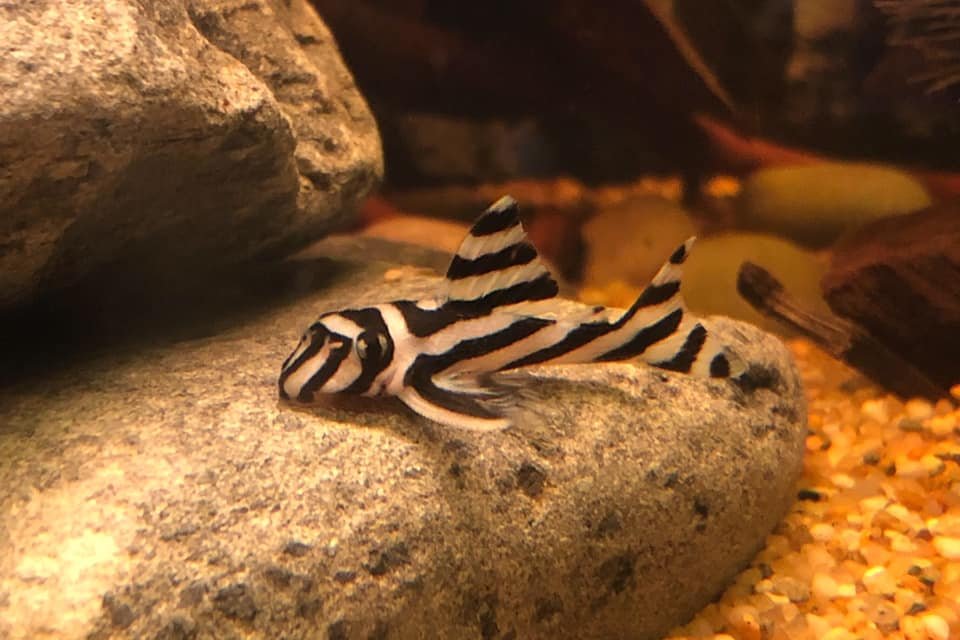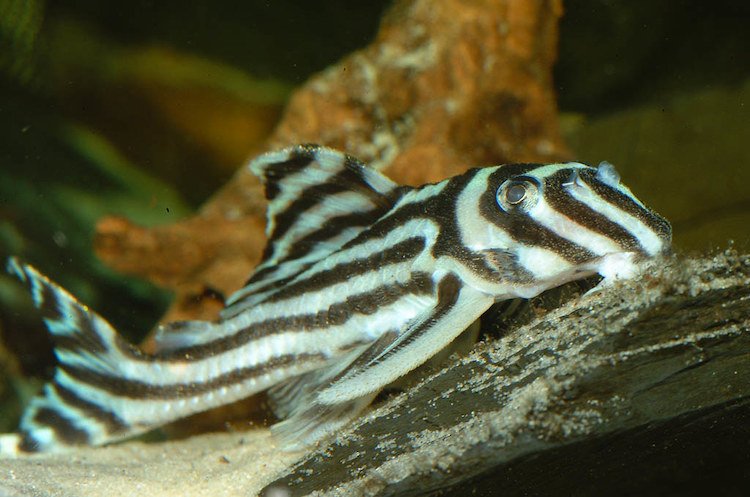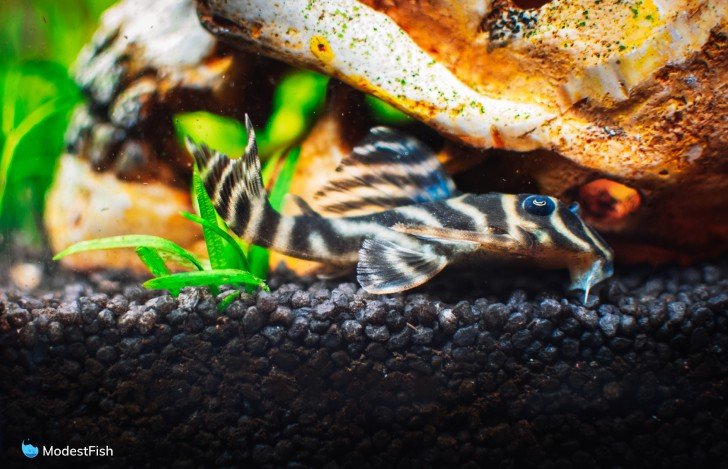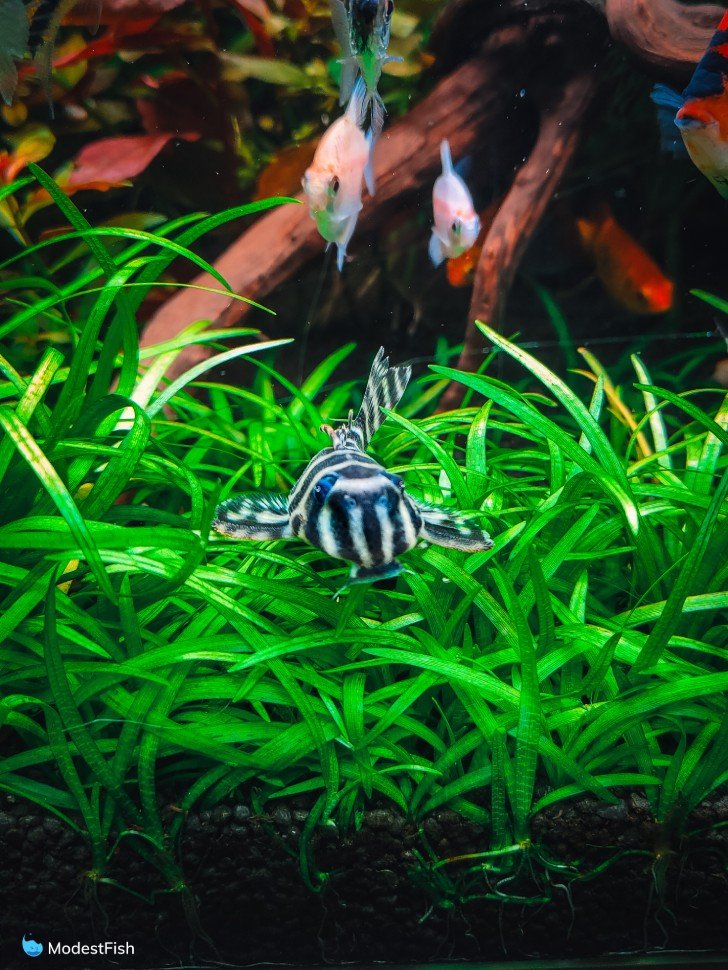With their contrasting black and white stripes, Zebra Plecos have been all the rage since their discovery in Brazil.
While they may not be the easiest to take care of, they’re still worth all the time and effort. Seeing them swimming and having fun in your tank will be a great pleasure, and they’ll eventually become the pride of your aquarium.
So, if you want to know how to best deal with its needs so that it can stick around for the longest time possible, keep on reading!
Overview: Origins & Appearance of Zebra Plecos

Hailing from Brazil, the Zebra Pleco (Hypancistrus zebra) has been under demand since its discovery in the 1990s. The principal reason it’s so popular is because of its truly unique appearance.
While it has the characteristic whiskers, suckermouth, and flat bottom of a catfish, its distinctive black and white coloration sets it apart from the other species. This alternating pattern is found running laterally all over its body and is also seen on its fins and tail.
And even though it’s a bit smaller than other catfish, averaging about 3-4 inches, it’s still quite impressive and striking in its own way.
It was originally discovered in the Big Bend area of the Xingu River, a branch of the Amazon River. The Xingu River had clear, fast-moving waters with plenty of hiding spaces.
However, since the construction of the Belo Monte Dam, the current strength significantly decreased, causing the number of these magnificent creatures to plummet until they eventually became an endangered species.
That’s why the Brazilian government has started several captive breeding programs for these fish and others affected by the dam construction in the hopes of replenishing those dwindling numbers.
And even though they still don’t sell or export this fish, other countries do, but for quite a substantial price due to its uncommonness.
Zebra Pleco Care Stats Overview
- Common names: Zebra Plecostomus, Imperial Pleco, Hypancistrus Zebra, L46, L98.
- Tank size: 20 – 30 gallons
- Temperature: 79 – 88 °F (26 – 31 °C)
- pH: 6.5 – 7
- kH: 2- 6
- Living zone: Bottom tank levels
- Temperament: Peaceful but moderately territorial
- Diet: Omnivore
Scientific Classifications
- Kingdom: Animalia
- Phylum: Chordata
- Class: Actinopterygii
- Order: Siluriformes
- Family: Loricariidae
- Genus: Hypancistrus
- Species: H. zebra
Zebra Pleco Lifespan
Zebra Plecos can live anywhere from 10 to 15 years. So if you’re a novice aquarist or you’re still exploring this hobby, you’re better off choosing a shorter-lived species.
Owning a Zebra Pleco requires someone who’s just as committed to taking care of a dog or a cat. It’ll take time, money, and effort to provide this fish with the best environment so that it can live as long as it possibly can.
A good diet paired with optimal water conditions will prevent most, if not all, diseases that can eat away at a Zebra Pleco’s life.
Sexual Dimorphism: Size & Coloration
Now, Zebra Plecos are not an easy species to distinguish between its males and females. There are only a couple of differences that can be very hard to spot unless you’re directly staring at and comparing the two.
First, the males are characterized for having bigger and broader heads, while the females have more of a rounded head shape. The males also have thicker and longer hairs on their pectoral fins, which are not as noticeable on the females. These hairs become more prominent when they’re ready to breed.
Zebra Pleco Care & Tank Setup

Best Tank Size for Zebra Plecos
A 20-gallon tank will work just fine for one Zebra Pleco, yet, a 30-gallon one will provide more space for the fish to swim and explore. Don’t let its relatively small size trick you into getting a small tank, though. This fish needs its space and will be much happier when it can swim to its heart content.
Since this species can be a bit territorial, getting an even larger tank is preferable to prevent territory fights if you plan to have more than one Zebra Pleco. This is even more important if you want to add this fish to a diverse community tank.
The Nitrogen Cycle
Any tank should be fully cycled before the addition of any aquatic creature, Zebra Plecos included. They’re even more sensitive than most other species to poor water quality and will greatly suffer when exposed to anything other than pristine water conditions.
Food and waste degradation produce nitrogenous toxic substances, namely ammonia, nitrite, and nitrate (to a lesser degree). When these three aren’t promptly and efficiently eliminated, the water quality takes a dive, and your fish consequently get sick and even die.
Therefore, you need to monitor your toxin levels regularly, especially in the beginning. Also, make sure to change about a quarter of your water once every week, accompanied by a thorough tank-cleaning session. This will ensure that your fish will be able to survive for the longest time possible.
If you’re curious about the nitrogen cycle and wish to read more about the subject, be sure to check out this article. It’ll tell you all you need to know about cycling your tank from A to Z.
Water Parameters
- Temperature: Zebra Plecos live in warm waters ranging from 79 to 88 °F. Try to stay somewhere in the middle so that you don’t accidentally pass the safe limits.
- pH: Zebra Plecos prefer water that’s as close to neutral as possible, barely tolerating anything lower than 6.5 or higher than 7.
- KH: A KH of 2 to 6 is ideal for this fish.
- Hardness: Interestingly enough, Zebra Plecos can survive in extremely soft or hard waters just the same. However, they’re typically bred in soft to moderately hard waters. You can imitate such conditions in your tank to ease your mind and stick to a GH of more than 5.
Zebra Pleco Tank Setup

When it comes to Zebra Plecos, providing hiding spaces should be first and foremost on your list. They spend most of their time hiding during the day and only come out at night. When they have multiple places where they can hide at a moment’s notice, they become much braver and tend to venture out more.
Therefore, you should scatter plenty of rocks and driftwood around the tank. Ceramic or rocky caves are also a great addition. Lastly, plants of all shapes and sizes are greatly appreciated by these Plecos, so you can plant whatever you want as long as it’s healthy.
The second thing that’s crucial for the health of your Plecos is having a strong water flow. Zebra Plecos can die if placed in non-moving waters, even with the correct water parameters. Most hang-on-the-back filters can provide a strong enough current as long as they’re still in good condition. Canister filters are better suited for the job, especially for tanks sized 30 gallons and up. Air stones and pumps will also help with the aeration and oxygenation of the water, so include one or two if you can.
Sand and fine gravel substrates are both okay to use with Zebra Plecos. Just make sure that the size of the gravel particles isn’t large enough for the Plecos to accidentally mistake for food. Also, avoid any gravel with sharp edges that can harm these bottom-dwelling fish.
Lastly, make sure to turn off any aquarium lights you have at night. Low lighting is usually okay, but it’s much less stressful for them to swim in darkness, so it’s better to turn off the lighting in the evening.
Diet & Feeding Zebra Plecos
Although Zebra Plecos are omnivorous, they’re more fond of a protein-rich diet. Whether that protein comes from dry, live, or frozen food is up to you. However, these fish prefer live food, which is generally much more beneficial than the other types.
Bloodworms, fly larvae, and brine shrimps are great sources of protein. Protein-rich dry food is also available and can be more convenient. Just make sure to purchase pellets instead of flakes. The pellets will sink to the bottom of the tank, allowing the Plecos to eat in comfort.
That isn’t to say that they won’t eat plant-based food. They don’t love it as much, but they’ll eat it just the same. Algae wafers, zucchinis, cucumbers, and mashed peas can be given from time to time as long as they’re small enough to fit into the Plecos’ mouths. Two or three feeding sessions should be enough in a day,
One thing to note, though, is that Zebra Plecos won’t go out of their way for food when other species are also trying to eat close by. If this goes on for a while, malnutrition and even death aren’t out of the question. So, make sure to feed them well away from other species to make them feel safe and reduce their stress.
In Tank Behavior & Compatibility

Zebra Plecos are more on the introverted side. They don’t really like socializing or going outside their established territories and caves. Since they’re nocturnal, you can only see them swimming around and exploring the tank at night when all the others are asleep.
They’re usually very shy and non-aggressive, though they can get quite territorial with their own kind (more on that below). So, it’s important to pair them up with other passive fish of a similar size and activity level.
Their tank mates should also be able to withstand strong currents and preferably live in the mid and upper tank levels to avoid accidentally imposing on the Pleco’s territory.
Some suitable tank mates for Zebra Plecos include Cardinal, Phantom, and Ember Tetras. Apistogramma, Platies, Harlequin Rasbora, and Denison Barbs are also good options.
Some peaceful bottom dwellers that can work well with Zebra Plecos include Celestial Pearl Danios, Zebra Otocinclus, Cherry shrimps, and freshwater snails.
Avoid any fish that is large, hostile, or tends to compete for food aggressively. Don’t place Zebra Plecos with large Cichlids, Rainbowfish, Hatchetfish, or Endlers. Threadfins and Discus fish are also inappropriate tank mates.
Keeping Zebra Plecos Together
As we briefly mentioned above, Zebra Plecos, specifically the males, are very territorial and can be very aggressive with each other. They fight when they’re trying to stake an area of the tank.
Fights can also happen when more than one male is competing for the same female. Battles can break out and lead to injuries that can cause diseases, like fin rot.
That’s why it’s advised to keep only one male with multiple females if you want a tank full of Zebra Plecos. Another solution is to get a large tank with numerous hiding spaces so that each male can claim one as his own. This will decrease the fights that can arise because they won’t feel as threatened.
Breeding Zebra Plecos
Breeding Zebra Plecos is the only thing that’s not complicated about them. Just by slightly adjusting a few things, like raising the temperature and oxygen levels, you can encourage them to start breeding.
When the female becomes laden with eggs, the male will start chasing and trapping her into his cave/nook. She’ll lay about 15 eggs, and then the male will fertilize them. He’ll continue guarding the eggs until they hatch. Some even stick around for a few more days until the fry can move on their own.
The fry will feed on their yolk sac for the first few days. Once they are done with it, they can start eating finely ground fry food, followed by brine shrimps at a later stage. They’ll look just like their parents after 2-3 months, only smaller, measuring up close to an inch.
Are Zebra Plecos Right For Your Tank?
Long story short, Zebra Plecos may be a bit of a hassle initially, but they’re all worth it in the end. Once you catch on to its habits and behaviors, taking care of it will be a no-brainer.
We hope this guide encouraged you to get your own Zebra Pleco, and if so, we wish you the best of luck.

Hello?
We are running a self-help center in Nowon-gu, Seoul. I recently started an ornamental fish project and needed a lot of information about ornamental fish. Thank you for the information.
From Seoul, Korea, Youngho Kim